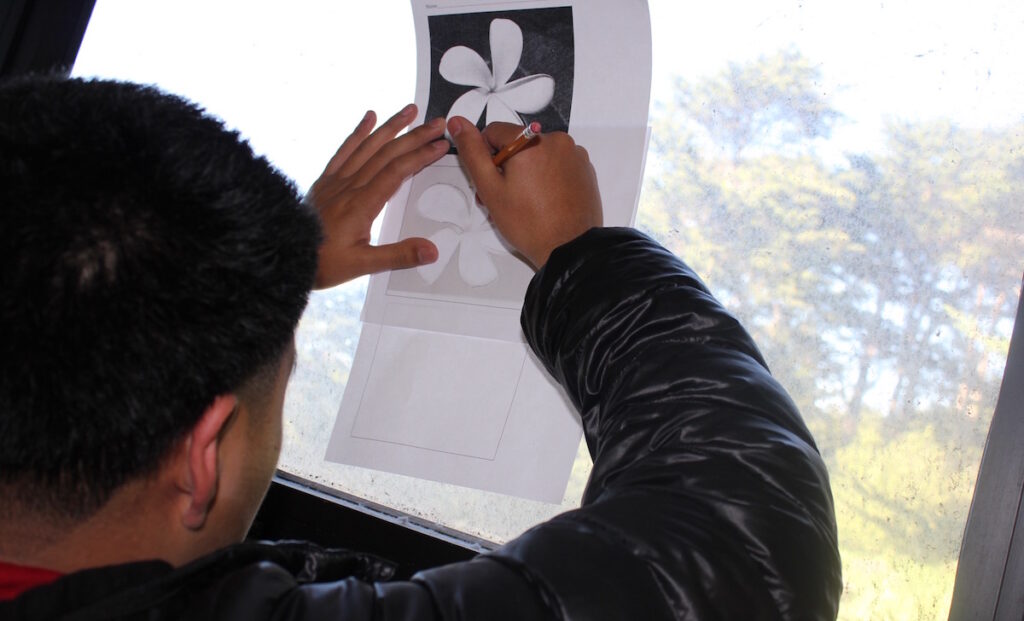Tracing used to be forbidden in my classroom. Basically, I saw it as an easy way out. I felt tracing prevented students from learning new skills and honing their observational abilities. I didn’t see any real value in it.
After some deep reflection, however, I’ve come to see tracing in a whole new light. If you’re on the fence about tracing, read on to see what changed my mind. You might just make space for it in your teaching practice.
Here is why I think tracing can have a justified place in the art room.

It Can Fit With the Goals of Your Class
When I really think about it, one of the main purposes of my art class is to make students believe they are artists who can creatively execute their ideas. Another purpose is to give students challenges they must solve using artistic means. These open-ended assignments force students to problem-solve. Is it really so bad if tracing is part of the solution?
Along with solving problems, another purpose of my art class is for students to feel and understand they can use art to communicate with others. For example, if a student is trying to create a visual story of their life, then they need to be able to envision, brainstorm, design a composition, make choices about artistic conventions, and execute a finished piece accomplishing their goals. The critical thinking skills, college-level work habits, and the artistic process involved can still be rigorous, authentic, and provocative even if tracing was used to transfer some imagery.
It Can Be a Form of Differentiation
I encourage all students to render using their eyes and hands. On average, there are thirty students in my classes. Generally, twenty of those students draw independently and ask for coaching occasionally. Five students might need some one-on-one instruction, but eventually, take on the challenge of drawing on their own. The remaining five students feel like they want to create pieces they are proud of but might have some specific challenges making it difficult to do so.
Perhaps their hand coordination is compromised. Perhaps they are not willing to step out of their comfort zone. Usually, when students choose, or demand, to trace, they are students with limited skill levels. Providing tracing as a tool can be incredibly helpful for them.

If you think about it, many other classes give extra support to students who need it. For example, students in an English class might get support via sentence starters. In math, this could look like using a calculator or notes on a test. So why can’t tracing be an accommodation in the art room?
Tracing even becomes a tool when a student can use their traced image as a spark for something else. After they trace, they still have to continue the artistic process. They still have to make choices to communicate their ideas. They still need to ponder what needs to happen for the piece to achieve their goals.
Making Sure Tracing Doesn’t Become a Default
Let me be clear: I do not promote tracing in the art room. I do not reference it as a strategy to help create an art piece. I still try to discourage students from doing it. When a handful of students approach me about tracing, or simply do it on their own, I try to talk them out of it. In fact, tracing is never allowed on low-risk assignments like those more about experimenting with line, shape, or color.
However, if a student is absolutely set on tracing and it keeps them focused and driven in a larger, open-ended assignment, then I allow it. It is a case by case basis. Tracing usually happens when an assignment is on paper, so they can see through to the other side. By offering students supports beyond paper, such as cardboard or wood, students then have to experiment with a new strategy. Of course, they could trace an image over their support with the hopes of leaving an impression on the surface. That is another form of artistic problem-solving.
Final Thoughts
People use tracing all the time. Cartoonists use it as a way to speed up the redrawing process in animation. Architects trace over blueprints. Muralists sometimes project images to trace outlines or detailed parts when transferring an image. It doesn’t have to be taboo.
And although I don’t encourage it, when students naturally find tracing as a way to help them solve artistic problems, I can accept it as a suitable strategy. Some students simply require some extra scaffolding to help them engage in and complete artistic investigations.
What is your view on tracing in the art room?
Are there any approaches or content you try to dissuade students from using?
Magazine articles and podcasts are opinions of professional education contributors and do not necessarily represent the position of the Art of Education University (AOEU) or its academic offerings. Contributors use terms in the way they are most often talked about in the scope of their educational experiences.





